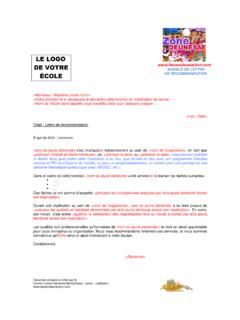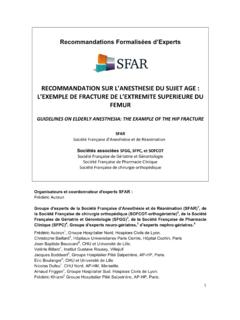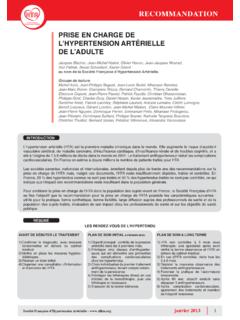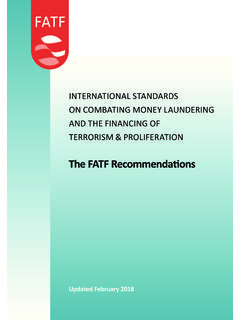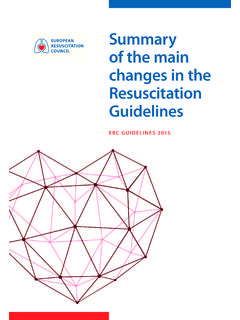Transcription of Recommended composition of influenza virus …
1 20 February 2013 Page 1 of 21 Recommended composition of influenza virus vaccines for use in the 2013- 2014 northern hemisphere influenza season February 2013 The World Health Organization (WHO) convenes technical consultations1 in February and September each year to recommend viruses for inclusion in influenza vaccines2 for the northern and southern hemispheres, respectively. This recommendation relates to the influenza vaccines for the forthcoming influenza season in the northern hemisphere (2013- 2014 ). A recommendation will be made in September 2013 relating to vaccines that will be used for the influenza season in the southern hemisphere ( 2014 ). For countries in equatorial regions, epidemiological considerations influence which recommendation (February or September) individual national and regional authorities consider appropriate.
2 Seasonal influenza activity, September 2012 January 2013 Between September 2012 and January 2013, influenza activity was reported in Africa, the Americas, Asia, Europe and Oceania. influenza A(H1N1)pdm093 viruses circulated at low levels in general except in some countries in Africa, Asia, Central and South America and Europe. influenza A(H3N2) viruses were predominant in most of North America, some countries in northern Africa, some parts of Asia and, early in the season, in some European countries as well as China. influenza B viruses circulated in many countries and were the predominant viruses in some. In the northern hemisphere , influenza activity was low in September and October. Increased activity was reported in North America in November, in Europe from December onwards and in a number of countries in Asia in December or January.
3 Regional A(H1N1)pdm09 activity was reported by a few countries in Asia and central America. An increase in activity was reported in many countries in northern , eastern and central Europe, with regional and widespread outbreaks in January. In northern Africa, widespread outbreaks were reported in Algeria in January. Localized and sporadic activity was also reported in many other countries in northern Africa, Asia and North America. influenza A(H3N2) virus activity was low in the Americas in September and October. Activity then increased in November and caused widespread outbreaks in Canada and the United States of America where it was the predominant circulating virus . In Asia, regional outbreaks occurred in Cambodia from September to November. Regional and 1 2 Description of the process of influenza vaccine virus selection and development available at: 3 Standardization of terminology of the pandemic A(H1N1)2009 virus : 20 February 2013 Page 2 of 21 widespread outbreaks were reported in the Republic of Korea and Japan respectively in January.
4 Low level activity was reported in Europe from September to November but increased in December and January in a number of countries. In northern Africa, activity increased in January with widespread outbreaks reported in Algeria. influenza B virus activity increased in North America from November with regional outbreaks reported by Mexico and the United States of America and influenza B virus became predominant in Mexico. In Europe, widespread outbreaks were reported in many countries in January. In Asia activity was generally low. Localized and sporadic B activity was also reported by a number of countries in northern Africa. In the southern hemisphere , influenza activity generally declined from September onwards. Some South American countries reported regional outbreaks in September and October due to A(H1N1)pdm09, A(H3N2) and B viruses. A(H1N1)pdm09 activity was reported at low levels with the exception of regional outbreaks in a few countries in central Africa and South America.
5 Regional A(H3N2) outbreaks were reported in Cameroon in October. influenza B viruses co-circulated with A(H1N1)pdm09 and A(H3N2) in Argentina causing regional outbreaks in September and October. Sporadic and localized A(H1N1)pdm09, A(H3N2) and B virus activity was reported in Oceania, central and southern Africa and a number of countries in South America. In tropical areas, many countries reported outbreaks of varying intensity of A(H1N1)pdm09, A(H3N2) and B viruses. Cambodia reported regional A(H3N2) activity throughout most of this period, declining in January. The extent and type of seasonal influenza activity worldwide are summarized in Annex 2. Zoonotic influenza infections caused by A(H5N1), A(H3N2) variant (v)4, A(H1N1)v, A(H1N2)v, A(H7N3) and A(H9N2) viruses From 19 September 2012 to 15 February 2013, 12 confirmed human cases of A(H5N1), 8 of which were fatal, were reported from Cambodia, China, Egypt, and Indonesia, where highly pathogenic avian influenza A(H5N1) is present in poultry.
6 Since December 2003, a total of 620 cases with 367 deaths have been confirmed in 15 countries5. To date there has been no evidence of sustained human-to-human transmission. One case of influenza A(H3N2)v was detected in November 2012 in the United States of America6. Since August 2011, a total of 321 cases with one death have been confirmed in the United States of America. To date there has been no evidence of sustained human-to-human transmission. 4 5 6 20 February 2013 Page 3 of 21 No human cases of influenza A(H1N1)v, A(H1N2)v, A(H7N3) or A(H9N2) were detected during the period 19 September 2012 to 18 February 2013. Antigenic and genetic characteristics of recent seasonal influenza viruses influenza A(H1N1)pdm09 viruses Between September 2012 and January 2013, all seasonal influenza A(H1N1) viruses detected worldwide were A(H1N1)pdm09.
7 Haemagglutination inhibition (HI) tests using post-infection ferret antisera indicated that the majority of A(H1N1)pdm09 viruses remained antigenically homogeneous and closely related to the vaccine virus A/California/7/2009. Sequence analysis of the HA genes of A(H1N1)pdm09 viruses indicated that the viruses fell into several genetic clades which were antigenically indistinguishable. The majority of viruses recently circulating belong to clades 6 and 7, which share the S185T and S451N changes in the HA. A small proportion of viruses showed reductions in reactivity in HI assays with ferret antisera raised against A/California/7/2009-like reference viruses; most of these carried amino acid substitutions in the region corresponding to positions 153-157 of HA, consistent with results obtained since May 2009. influenza A(H3N2) viruses Antigenic characteristics of A(H3N2) viruses collected from September 2012 to January 2013 were assessed with panels of post-infection ferret antisera in HI and virus neutralization assays.
8 The majority of recent A(H3N2) viruses tested were antigenically similar to the cell- propagated reference viruses A/Victoria/361/2011 and egg and cell-propagated A/Texas/50/2012. However, post-infection ferret antisera raised against egg propagated A/Victoria/361/2011 virus had titres against most recent cell-propagated viruses that were at least 8-fold lower in HI and neutralization tests, compared to the homologous titre (Table 1). The HA genes of most recent A(H3N2) viruses fell into phylogenetic clade 3C while the remainder fell into other phylogenetic clades such as 3A, 3B, 5 and 6. These genetic clades, including those clade 3C viruses with amino acid substitutions T128A, R142G and N145S, were antigenically indistinguishable in HI (Table 1) and neutralization assays. influenza B viruses influenza B viruses of the B/Victoria/2/87 and the B/Yamagata/16/88 lineages co-circulated.
9 Viruses of the B/Victoria/2/87 lineage were prevalent in some countries; B/Yamagata/16/88 lineage viruses have continued to increase in proportion becoming dominant in many countries. The HA gene sequences of most B/Victoria/2/87 lineage viruses belonged to the B/Brisbane/60/2008 genetic clade and, in HI tests with post-infection ferret antisera, the majority of viruses were antigenically closely related to the vaccine virus B/Brisbane/60/2008. The HA genes of most B/Yamagata/16/88 lineage viruses fell within genetic clades 2 or 3, with the proportion of viruses in clade 2 markedly increasing in many areas 20 February 2013 Page 4 of 21 during this period. Many viruses with HA genes in these clades could be distinguished antigenically in HI tests with some post-infection ferret antisera (Tables 2a and 2b). Resistance to influenza antiviral drugs Neuraminidase inhibitors The majority of A(H1N1)pdm09 viruses were sensitive to oseltamivir.
10 Of the small number of oseltamivir-resistant A(H1N1)pdm09 viruses detected, some were linked to the use of this drug for prophylaxis or treatment. In all instances, resistance was due to a histidine to tyrosine substitution at amino acid 275 (H275Y) in the neuraminidase; all viruses remained sensitive to zanamivir. All A(H3N2) and B viruses tested were sensitive to oseltamivir and zanamivir. A smaller number of viruses were also tested for susceptibility to peramivir and laninamivir and all were sensitive. M2 inhibitors M gene sequencing of A(H1N1)pdm09 and A(H3N2) viruses revealed that all those analysed, with one A(H3N2) exception, had the serine to asparagine substitution at amino acid 31 (S31N) of the M2 protein which is known to confer resistance to the M2 inhibitors, amantadine and rimantadine.










